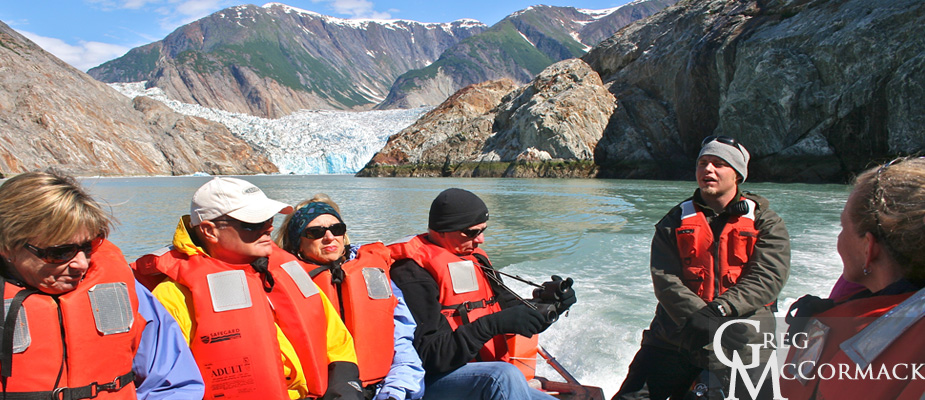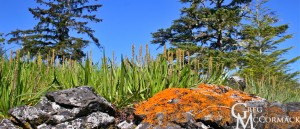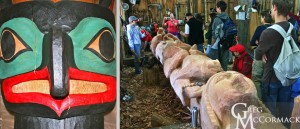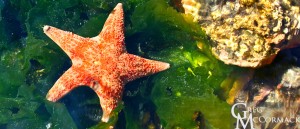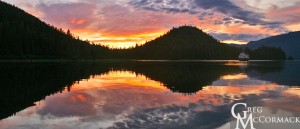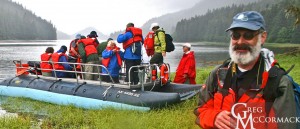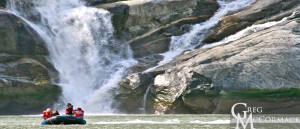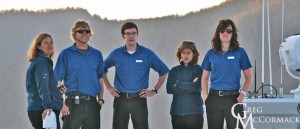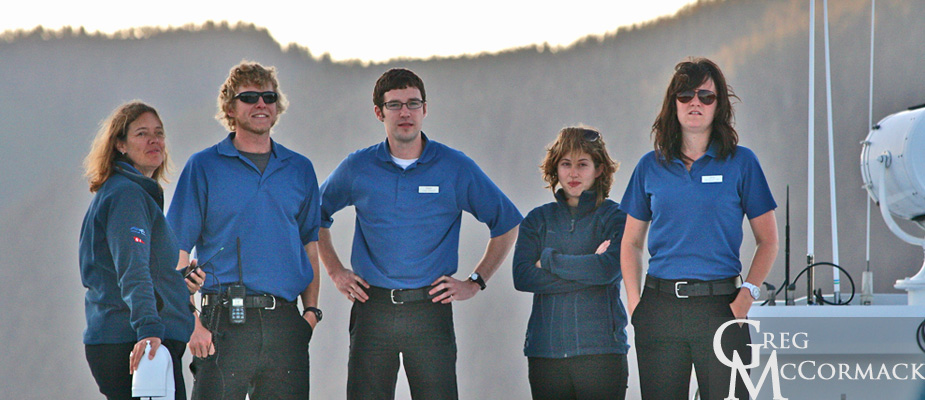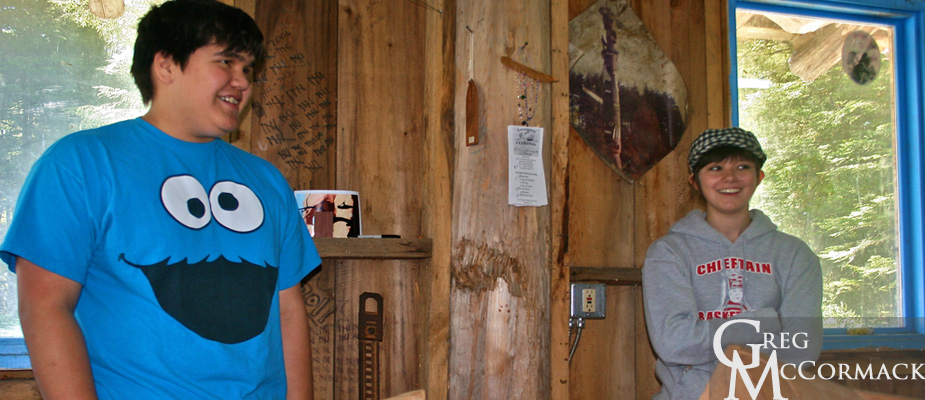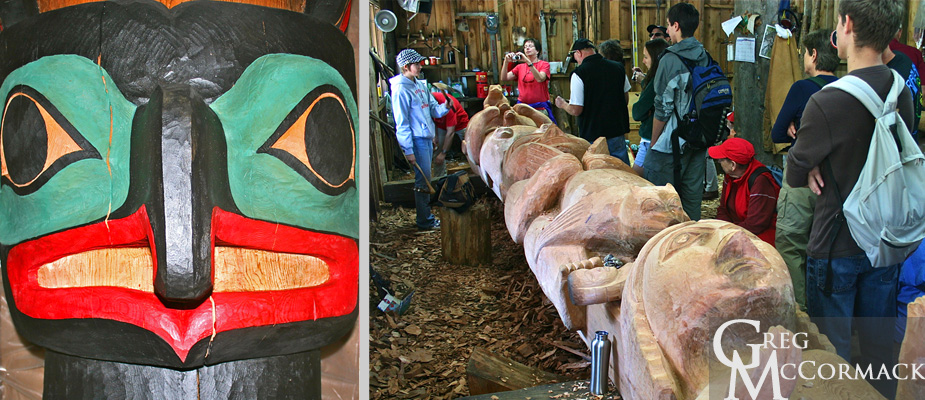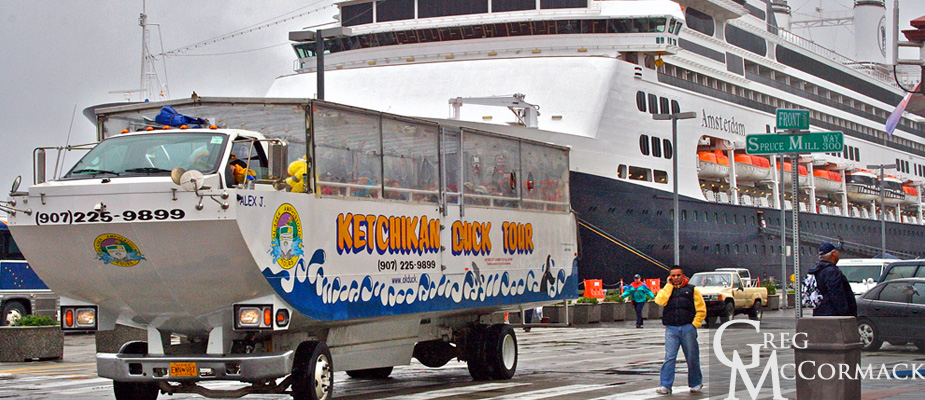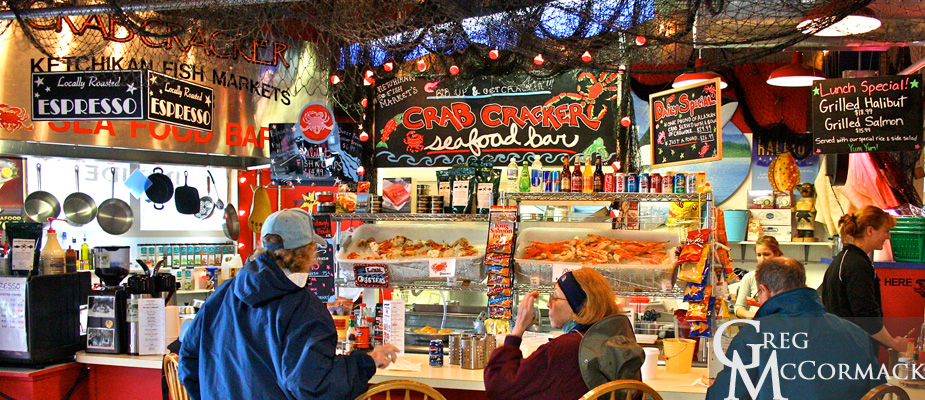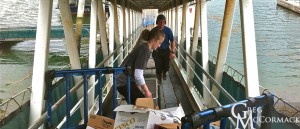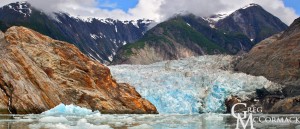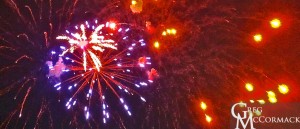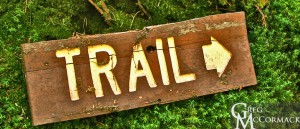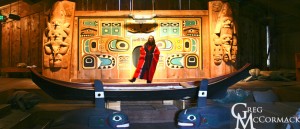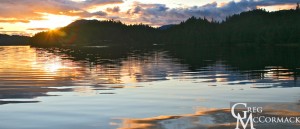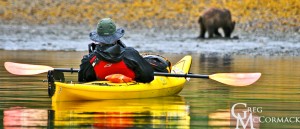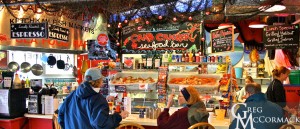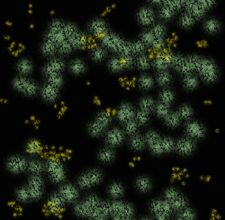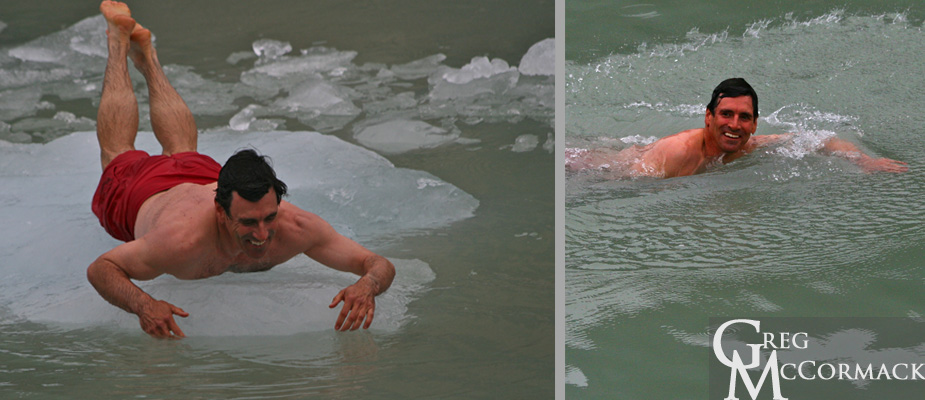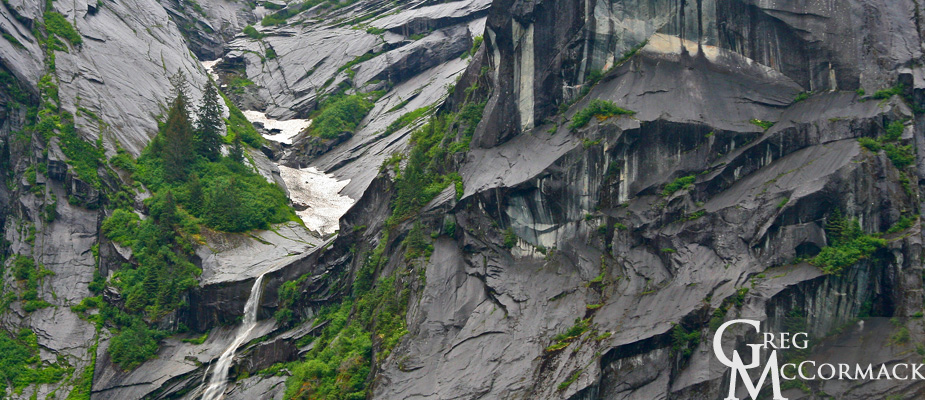Search results
Sunday | July 17
October 3, 2011 by admin
Filed under InnerSea Discoveries
Tracy Arm & Sawyer Glaciers
“Domes swell against the sky in fine lines as lofty and as perfect in form as those of the California valley, and rock-fronts stand forward, as sheer and as nobly sculpted. No ice-work that I have ever seen surpasses this, either in the magnitude of the features or effectiveness of composition.” –John Muir
John Muir, writing in his book Travels in Alaska, described Tracy Arm as a “wild unfinished Yosemite”.
We awake to a fine day. The anchor is lifted at 6 a.m. and the Wilderness Discoverer cruises up the magnificent fiord that is Tracy Arm. Yosemite-like domes, waterfalls that seem to come right out of the sky, and rainforests that exhibit many shades of green are passed as we motor at the speed of 9-knots up the 23-miles to the face of the Sawyer Glacier.
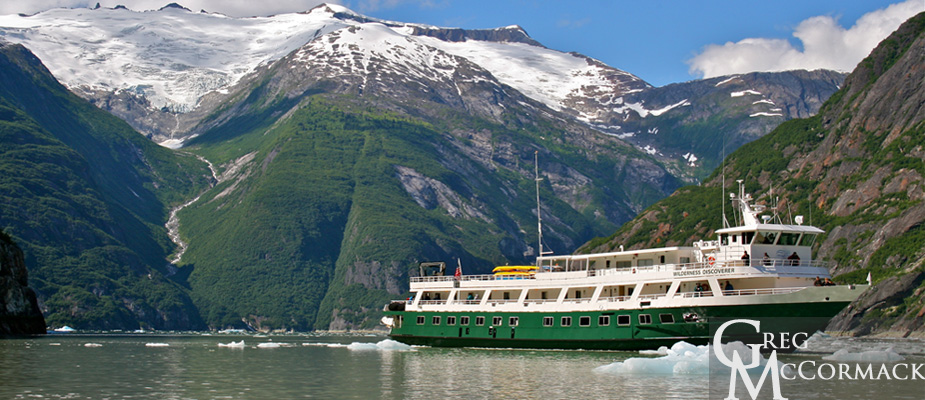
This is the Tongass National Forest, the largest National Forest in the United States at almost 17 million acres in size. It ranges from the Southeast Alaska panhandle between Ketchikan and Yakutat. It incorporates the Alexander Archipelago, located in the Inside Passage between the Coast Mountain Range and the Gulf of Alaska in the Northeast Pacific Ocean. The Tongass happens to have the largest contiguous, intact temperate rainforest in the world.
The temperate rainforest biome ranges from the narrow strip of land between northern California and Kodiak Island, Alaska. Some of the hallmarks of this rainforest is the presence of Sitka Spruce, a profusion of epiphytes such as mosses and lichens, a climate regime that includes around 100-inches of precipitation a year and the presence of nurse logs.
Small boat tours are offered to bring guests up close to the Sawyer Glacier. Photographic opportunities abound for camera-toting guests.
Brash ice is quite thick. Birds are flying back and forth in front of the tidewater glacier and seals are hauled out on small ice-bergs or “growlers”.
We are lucky to have two wilderness kayak rangers join us with two of their “artists-in-residence” volunteers. Our Tongass National Forest Rangers Solan Jensen and Sean Reilly give an insightful talk on the history of wilderness in the dining lounge.
After disembarking the kayak rangers, we ask guests to participate in three rounds of talks surrounding our adventure program of kayaking, stand-up paddleboarding or SUP, and how to behave in bear country. I lead the talk on SUP in the lounge with an assistant to “model” appropriate techniques.
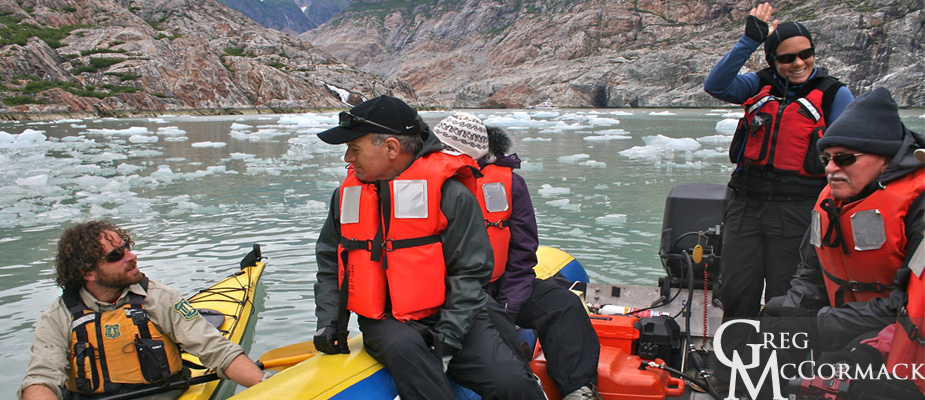
It’s amazing how SUP has become the latest trend in ocean sports. As a fitness sport, it uses all of the major muscle groups. It works the core and legs while you try to balance and the upper body while paddling.
It’s easy to carry a SUP and that is one of the major advantages over having a sea kayak. On calm, flat days the only real hazard for SUP’ers is navigating wakes from passing boats. These boards are wider and more stable than a regular surfboard. However, I would not recommended trying to walk the nose and “hanging ten”.
For novice paddleboarders, it’s worth trying it more than once to build a comfort level and to see if the sport is enjoyable. Every time you get out on the water while here on vacation will make it that much easier to try it again back home.
The minimal effort of SUP-ing (not a great acronym, I just realized) for just a few minutes while circumnavigating the Wilderness Discoverer will allow a partner or crew to photo-document your efforts. That way you can prove to kith and kin how adventurous you really were in Alaska.
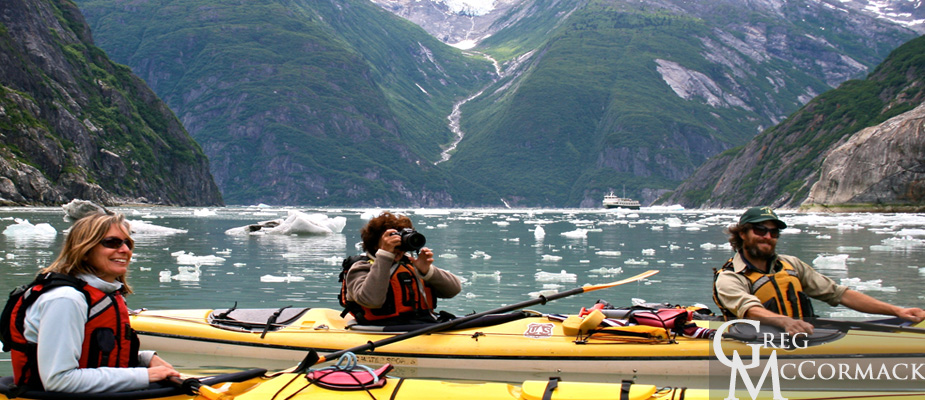
My overall message is to encourage folks to “get up, stand up…stand-up for bragging rights!”
The afternoon is spent whale watching in the waters adjacent to Admiralty Island National Monument. Kootznahoo or “Fortress of the Bears”, has the greatest concentration of brown bears in the world, about 1 bear per square mile on the 1,700 square mile island. We motor too far away to spot brown bears (visitors that want to see bears can go to Pack Creek on the northeast side of the island).
Humpback whales are spotted exhibiting a range of behavior such as spouting, lob-tailing and breaching. These fascinating baleen whales have travelled all the way from Hawai’i to feed all summer long.
Friends stay up late enjoying a lingering twilight and the ever-changing seascapes that almost hypnotize to a state of nirvana.
where is gmack now? innersea discoveries expedition week 11
It has been an exciting week on the InnerSea Discoveries Expedition Click Links Below to read daily updates from Week 11 of the Trip:
July 10 – July 16, 2011
Sunday | July 10
“Kayaking, Sauntering, Kelp-Bugling”
Monday | July 11
“Totems, Plankton, Weather”
Tuesday | July 12
“Invertebrates and Our Sister-Ship”
Wednesday | July 13
“Phantasmagorical Seascapes”
“Tidal Ebb & Flow”
Friday | July 15
“Killer Whales”
Saturday | July 16
“The Capitol City of Juneau”
Saturday | July 16
September 26, 2011 by admin
Filed under InnerSea Discoveries
The Capitol City of Juneau
“Find your place on the planet, dig in and take responsibility from there.” –Gary Snyder
“If I were to choose the sights, the sounds, the fragrances I most would want to see and hear and smell–among all the delights of the open world–on a final day on earth, I think I would choose these: the clear, ethereal song of a white-throated sparrow singing at dawn; the smell of pine trees in the heat of the noon; the lonely calling of Canada geese; the sight of a dragon-fly glinting in the sunshine; the voice of a hermit thrush far in a darkening woods at evening; and–most spiritual and moving of sights–the white cathedral of a cumulus cloud floating serenely in the blue of the sky. Edwin Way Teale, “On a Final Day”
Disembarkation day!
It’s off to many different destinations around the country for our guests. It is very tempting to take them up on their offers to stay if ever we visit their hometowns. Juneau is bustling this morning as we dock alongside the pier adjacent to large cruise ships and a float plane dock
A local tells me that the recent U.S. Census had between 5 and 6,000 people moving out of the capital city of Juneau, a drop from around 31,000 to 25k over the last 10 years.
Crew work hard in anticipation of another group that will board in less than 8 hours.
Monday | July 11
September 26, 2011 by admin
Filed under InnerSea Discoveries
Klawock
“The white man must treat the beasts of this land as his brothers. What is man without the beasts? If all the beasts were gone, we would die from a great loneliness of spirit…for whatever happens to the beasts also happens to the man. All things are connected. Whatever befalls the earth befalls the children of earth.” –Chief Seattle, Puget Sound Suwamish Tribe 1854
More sunshine! We awake early and enjoy the slow cruise and docking at the pier in the town of Klawock, located on the windward side of Prince of Wales Island.
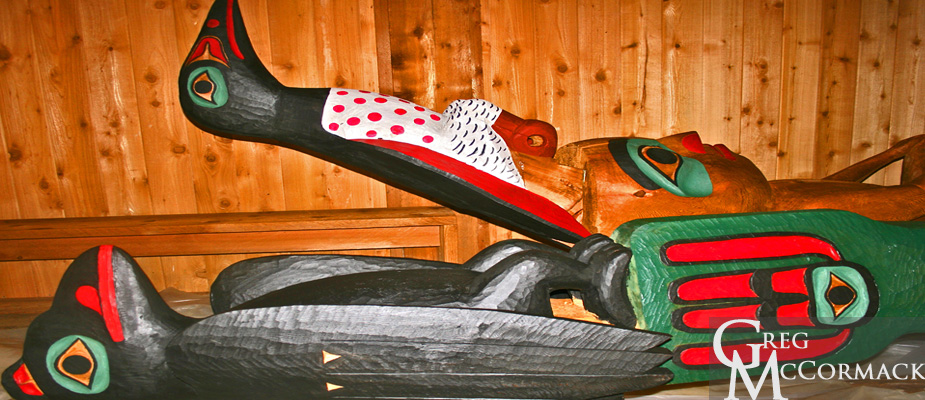
Our Tlingit hosts take us on a walk to see the totem-carving shed.
We also see the longhouse that holds the newly carved and painted totems.
A ¼-mile away behind the local shopping mall lies an empty lot that has dozens of old totems lined up in a row, exposed to the sun and rain. On the 1-mile walk back toward the ship, we visit the totem park at the center of town. Celebrations and pole-raising will take place in early August for 5 or 6 totems. Years of hard work and carving have gone into these amazing totems.
I have a couple of volunteers help me with a plankton tow on the pier. The pier lies in the middle of an estuary, where the river meets the sea. We can see the bounty of life floating beneath the ship including schooling fish, ctenophores and the lions mane jellyfish.
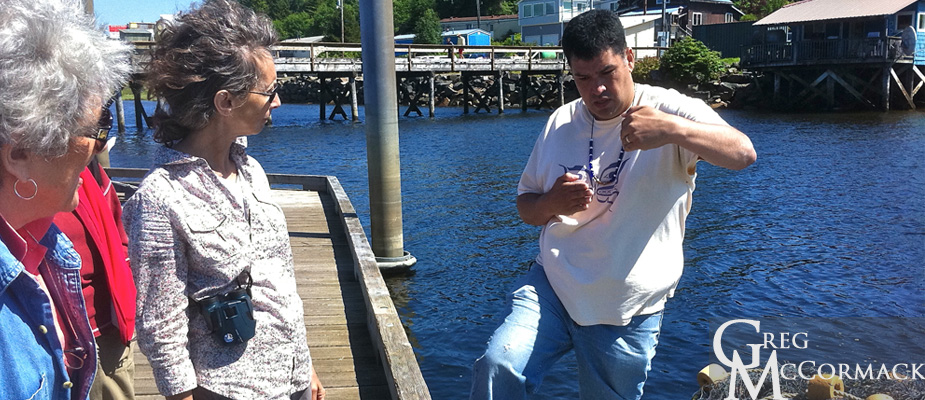
Back aboard, I set-up two stereoscopes and pour the contents of the plankton tow into specimen dishes for observation.
In the afternoon, we are back in Sea Otter Sound. Our wildlife spotters are able to find a couple of sea otter rafts. An announcement from the bridge alerts guests about a small-craft advisory in effect. Therefore, we won’t be crossing Chatham Strait over to Baranof Island.
As a result of the small-craft warning, we’ll be looking at an itinerary change that we all will be excited about. It sure is appreciated when folks on an expedition-style voyage have a flexible attitude, adapting to different circumstances!
The unknowns on any trip add to the excitement! Our expedition leader and captain spend hours pouring over the charts to determine what would provide the most interesting alternative (to sea-sickness and possible damage to items on the ship).
Saturday | July 9
September 14, 2011 by admin
Filed under InnerSea Discoveries
“If I had influence with the good fairy who is supposed to preside over the christening of all children, I should ask that her gift to each child in the world be a SENSE OF WONDER so indestructible that it would last throughout life, as an unfailing antidote against boredom and disenchantments of later years, the sterile preoccupation with things that are artificial, the alienation from the sources of our strength.” –Rachel Carson
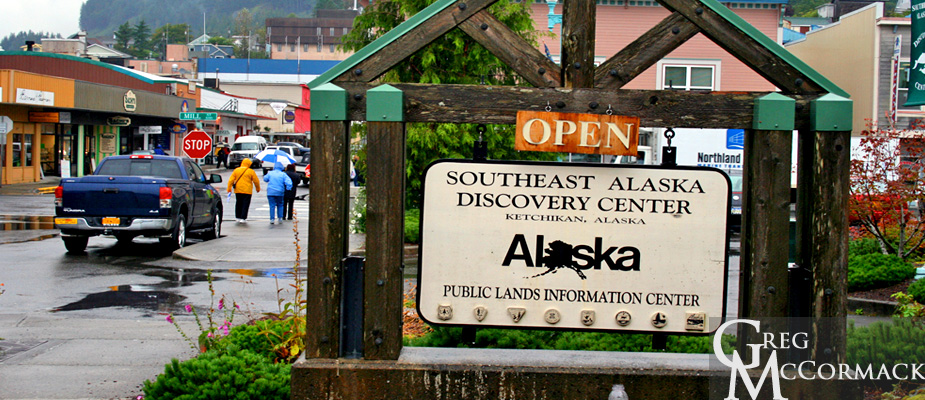
All of the M/V Wilderness Discoverer crew forms a line off of the ship on the dock and we shake hands, hug and express our fond farewells to passenger-guests. Folks are very thankful for the natural history interpretive talks I gave over the week. My favorite compliment was one that spread over the ship about a search engine like Google called “Greg-gle”. A guest explained: “Instead of finding an answer by Googling, we think the best way to get an answer is to Greg-gle a query. You were so full of amazing answers on a multitude of subjects.”
One passenger said I would make an amazing minister with my views on Nature. Another said that I was more than a PhD…that I must have several honorary degrees with all of my knowledge on a variety of subjects. An Aussie stated I should run for President and that I would be famous in all of Australia for my ice-swimming and imitation of a seal on an ice-berg.
My fellow colleagues get a boost from the many compliments they received for a job well done. Each one of us, with our outgoing personalities and the pride we take in our jobs, makes small-ship cruising a big hit in the cruise industry. We feel good in knowing that our new company is profitable, as we hear rumors that InnerSea Discoveries may be purchasing some new vessels for upcoming itineraries next year. Kudos to the home office for their expertise in choosing this itinerary and recruiting great guides and crew. We are all giving memories for a lifetime for our guests.
After preparing the ship for the next group of guests, we have about an hour to ourselves onshore for R&R or personal business. It is fun to see how busy this town can get with a huge cruise ship in port!
where is gmack now? innersea discoveries expedition week 10
It has been an exciting week on the InnerSea Discoveries Expedition Click Links Below to read daily updates from Week 10 of the Trip:
July 2 – July 9, 2011
Saturday | July 2
TURNOVER DAY = SWABBING THE DECKS
Sunday | July 3
GLACIER CALVING, SEALS & WHALES
Monday | July 4
HAPPY 4TH OF JULY, EVERYBODY!
Tuesday | July 5
MOOSE PELLETS
Wednesday | July 6
CHIEF SHAKES LODGE
SNORKELING AND BANJO PLAYING
Friday | July 8
CLAM-EATING BEAR
Saturday | July 9
“WE NEED THE GREGgle APP!”
Saturday | July 2
September 14, 2011 by admin
Filed under InnerSea Discoveries
“If there is magic on this planet, it is contained in water.” –Loren Eisely
The M/V Wilderness Discoverer lifts anchor and motors north through Gastineau Channel and docks beneath the rising peaks of Mount Roberts and Mount Juneau. All (departing passenger) luggage is taken off of the vessel and carried up the dock ramp to the waiting buses.
A fond farewell takes place between crew and guests as the latter disembark to hug and shake hands with their favorite crew members on the dock. Great memories and sad goodbyes!
The excitement for the morning is when I crashed a fully-loaded, heavy rolling cart on the ramp leading down to the pier. Luckily none of the eggs in the 13-dozen box broke.
Note to self: Do not use a cart that lacks hand brakes when the tide is low. All of the carts but one has a hand brake. Kristen helps me re-load and we get back to transporting stores from truck to ship.
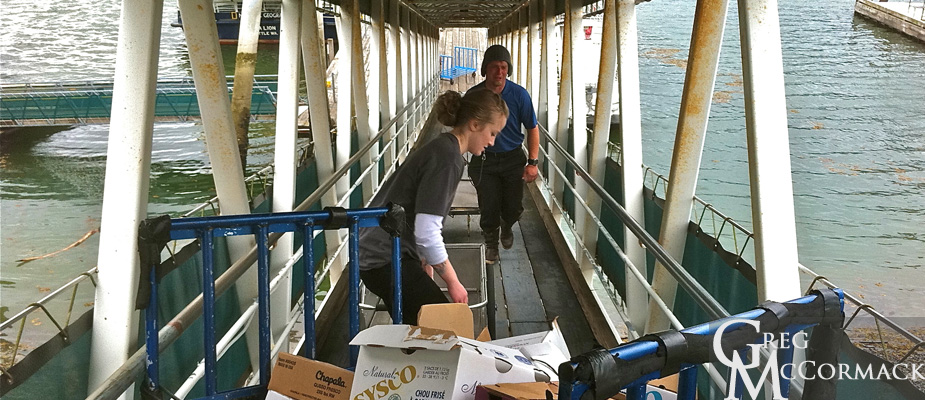
All available hands on the ships crew prepare for a new group of passengers that will board the vessel at 16:30 hours. All decks are swabbed, port holes washed, sheets changed, cabins and heads cleaned, dirty laundry and garbage hauled off ship, and galley stores stowed.
After our welcome aboard orientation meetings with the deck, engineering, hotel and expedition leads, the M/V Wilderness Discoverer pulls away from the Juneau dock and heads south in Gastineau Channel. We spot some Humpback Whales feeding just outside of the Taku Inlet and enjoy the sunset on the outside decks.
Our destination for tomorrow will be the one of three spectacular fiords in the Tracy Arm—Fords Terror Wilderness, about 46 miles south of Juneau. The area encompasses close to 700,000 acres of rugged Coast Range mountains bordering Holkham Bay, the spot where we will be anchoring tonight.
The three dramatic fiords are Endicott Arm, Fords Terror and Tracy Arm, all of which trend west-to-east through the Coast Mountain Range. The three tidewater glaciers drop down from the Stikine Icefield and regularly calve ice bergs into the ocean.
Friday | July 1st
September 10, 2011 by admin
Filed under InnerSea Discoveries
The Green Flush and an Ice Swim
Speaking of plankton, I awake and visit the head (bathroom) without turning on the light and shout “Wow” several times, loud enough to awaken my cabin-mate. I couldn’t contain my enthusiasm.
You’ve heard of the green flash? Been there, seen that. You have to see the green flush! I will have to take a picture of it next time I see it. You see, our septic system works on sea water. In just a few liters, you can have tens of thousands of microscopic organisms. On rare occasions, the entire bowl in the head is awash with a blue-green light. When the head is flushed, hundreds of miniature lights sparkle and swirl. It’s as if you are in the beginning of a Star Trek or Star Wars movie with distant stars moving quickly past the camera.
I run out of my room and start inviting my fellow shipmates over to see it, but it sure does take a lot of coaxing to get anyone interested. Perhaps it’s because the area inside our bathrooms are so small…standing in the center with your arms akimbo is all the room you have to maneuver.
What I learned years ago is that the light is caused by a luciferin-luciferace enzymatic reaction, a luminescence of a biological kind, otherwise known as bio-luminescence. If I remember correctly, the organisms that cause this are often Noctiluca, Gymnodinium, Ceratium and Gonyaulax. What’s amazing is that 80% of the organisms that live in the bathy-pelagic or deep water realm of the ocean exhibit some type of bioluminescence in order to attract mates, lure food or just communicate amongst each other.
The M/V Wilderness Discoverer motors into Endicott Arm to the Dawes Glacier. A commotion suddenly erupts at the stern of the vessel. A large group convenes near the swim step for the newest rendition of the Polar Bear Club. I grab a pair of swim trunks, and squeeze my way forward to the platform. I dive in and swim out to the nearest “growler” ice-berg. I climb up, imitate a harbor seal by laying down on the ice and look back at the ship. The water clears out of my ears and I hear all the cheering and invitations to join folks in one of the ships hot tubs. I dive back in and enjoy the sensation of the thirty-something degree Fahrenheit water.
In case you haven’t guessed, I am a pagophilic or ice-loving mammal just like the walruses, seals and whales that inhabit waters in Alaska. I may not have as much blubber, but the feeling of cold water is fabulous, like drinking 20 cups of coffee without having any jitters. A clean, invigorating sensation, for sure!
The other highlight of the day is motoring up Fords Terror, a spectacular fiord that John Muir named “Many Yosemite”.
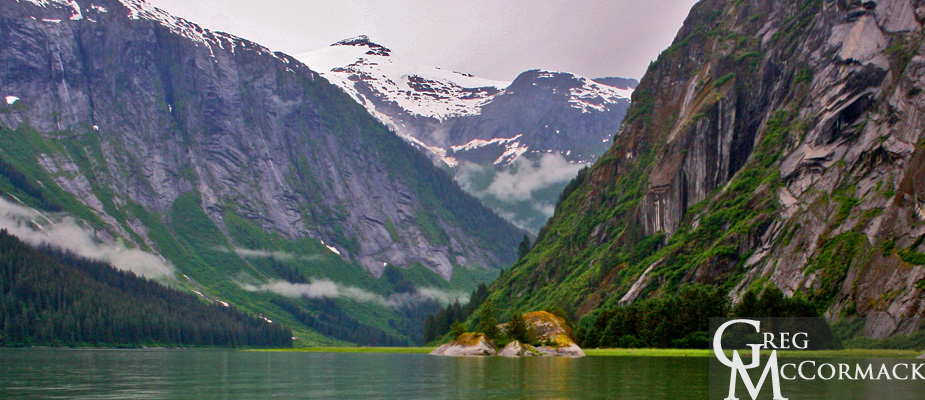
In his book “Travels in Alaska” Muir wrote: “…we found ourselves on a smooth mirror reach between granite walls of the very wildest and most exciting description, surpassing in some ways those of the far-famed Yosemite Valley. We drifted silent and awe-stricken beneath the shadows of the mighty cliffs…a grander array of rocks and waterfalls I have never yet beheld in Alaska…one of my brightest and best of all my Alaska days.”
Small boats are the best way to see so much grandeur in so short a time. Waterfalls were everywhere along with sheer cliffs and outstanding scenery. Fords Terror would be well worth a longer visit, preferably several days via sea kayak.


